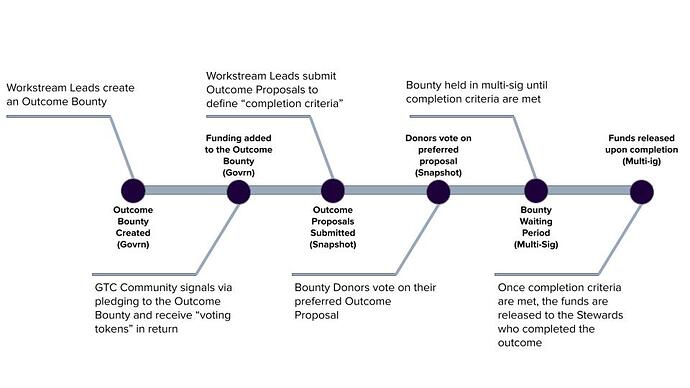Hey everyone  - I’m Aaron, one of the GTC Stewards and founder of Govrn. Over the past couple of weeks since GTC launched, we’ve witnessed a couple of issues.
- I’m Aaron, one of the GTC Stewards and founder of Govrn. Over the past couple of weeks since GTC launched, we’ve witnessed a couple of issues.
- GTC holders want more input on governance as well as
- Stewards and Contributors being drained of time without a clearly defined incentivization/reward structure.
You can see references to this problem in the proposed solutions here and here. I also noticed during the Akita discussions, the community requested a better way to directly participate in the governance process.
Proposal
I wanted to propose a solution we’ve been working on at Govrn over the past 2 years called Outcome-Based Donations (OBDs). OBDs are escrow transactions that allow anyone to pool money towards an outcome or metric for a team to complete. Think of these as outcome-conditional bounties/a mashup between a Kickstarter + OKRs. For example, using OBDs we can raise a fund that could be unlocked by stewards on completion of building more anti-collusion tools and is only released once the predefined criteria are reached.
The benefits of OBDs are:
- Allowing the GTC community to have a voice in governance
- Enable Stewards to spend more time building GTC Community desired outcomes and less time “politicking”.
- Turns information asymmetry into a public good.
To test these out, we’re working with several of the GTC Workstream leads to build a few “pre-defined” OBDs for the GTC community to contribute towards.
Background:
We’d previously been looking for the right communities to pilot OBDs as a governance model and I had put out this tweet for a starting point. After connecting with several projects, Yalor connected me with the GTC team to see how we could use this for the GTC Community. We have since been working with a couple of workstream leads and decided to pilot OBDs with two specific workstreams and see how they worked out.
Once this first round of workstream-specific pre-defined OBDs are created, we will open up the process for anyone to create or request an OBD for GTC.
Process
Below outlines the process for how GTC Workstream Leads can set up OBDs:
-
Create an Outcome Bounty
- Workstream leads can create an Outcome Bounty to be listed on Govrn. This is essentially a way for Leads and Stewards to “signal” what their priorities are.
-
GTC Community Signals Support
- If GTC Community Members support one of the listed bounties, they can signal their support by “pledging” to the Outcome Bounty.
-
Outcome Proposals are made on Snapshot
- Workstream coordinators submit their “conditions” on what the completion criteria are for the given Outcome Bounty. Anyone who signaled their support by pledging to the Bounty can vote on the proposal they prefer.
-
Winning Proposal Finalized
- Once an Outcome Proposal has been voted on by the Outcome Donors, there is a grace period for any donors to ragequit. This allows for anyone who pledged to the bounty but didn’t vote for the winning proposal to ragequit their funds back if so desired.
-
Bounty is held in multi-sig until the completion criteria have been met
- After the grace period, the bounty is held in a multi-sig until the completion criteria have been met. The signers will be high trust and high reputation GTC Stewards/Workstream Leads and will be identified during the Outcome Proposal process
- If the completion criteria are not met within a defined timeframe, then the funds will be returned back to the users to ragequit.
We think that OBDs enable a bottoms-up governance model and creates a positive-sum game where Stewards and Stakeholders work together. Part of the goal of why we’re all here in Ethereum and Crypto is to re-imagine how our political structures work. IMO, the GTC Community is the perfect place to start building what the next generation of politics and governance should be like. We’re excited to see how these first tests go and want max community participation  .
.
We will be providing updates on the progress using this thread, so please comment with any thoughts here and follow along.
